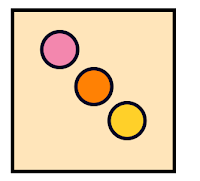Grades 2-5
The ordinary dice is indeed a very versatile object; not just associated with a plethora of board games - but also serves its purpose as an important tool of learning - a math manipulative to be precise.
Here's one way of how you can use a simple six-sided dice to graph data on a line plot.
Do they mean the same?
Can they be used interchangeably?
To answer the above, well - both terms refer to the same object - the difference lies in the plurality.
'Die' is the singular term - it refers to one.
'Dice' on the other hand, as per modern standard English, could be used to refer to the singular and the plural. It refers to one or more than one.

So which term do I prefer?
'Dice' of course - for one thing it doesn't have the negative connotation associated with the synonym 'die' - as in 'kicking the bucket' and for another it supersedes in versatility as it can represent both the singular and plural.
Now coming back to the line plot activity that dictates the rolling of a dice (singular form - one die), all your students need is one six-sided dice, a task card outlining the task, a line plot template and a response sheet.
The objective is to roll the dice 15 times and record the outcome of each roll on a line plot graph using the 'X' symbol.
Then comes the task of interpreting the data collected on the line plot graph.
How many times did a particular number appear when the dice was rolled?
Which was the most rolled number and the least rolled number?
These kind of constructive questions help a student reflect on the data plotted on the line plot graph.
Needless to say, it also connects to real-life data and makes the abstract more concrete.
Put this activity at a center and your students are all ready to have some hands-on fun.

Storage is all taken care of too - simply place the templates in a file folder and glue on the attractive cover to entice. Here is a choice of two.
Remember to also insert the task card outlining the task and sample completed templates so your students have a better idea of how the completed task looks like.
Other than a dice manipulative to record data on a line plot graph, your students can also use coins, candy (M&M's), spinners, visual cards to name a few.
This line plot uses a fraction cube that students can roll, akin to rolling a dice.
And this line plot uses a spinner that students can spin to win a make-believe prize.
This bundle below has 13 such center activities - all deal with plotting and interpreting line plots using hands-on data.
If you've made it all the way to the end of this post - thank you and here's a link to the free templates required for creating and interpreting a line plot graph using a dice mentioned in this post.
To sign off, if you're like me and sometimes have a moment of when to use 'die' or 'dice' - I like to recall this simple analogy - namely, that we humans only live this beautiful life once and this notion is synonymous with the math manipulative 'die' - in that it also interestingly denotes - one.
Happy teaching!
Until next time...
















No comments:
Post a Comment